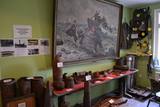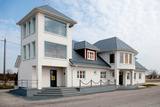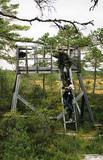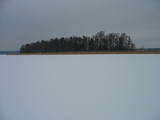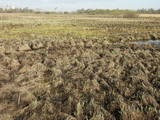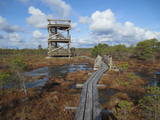| Nr | Name | Beschreibung |
|---|---|---|
|
Das Museum wurde 2007 eröffnet. In der Exposition sind ein 180 mm Kanonenrohr, Rekonstruktion der Staatsgrenze, Zivilschutzräume, Panzerwagen, Grenzüberwachungsboot, Meeresminen. Im Hauptgebäude wird Beobachtungsradar, Waffenabstellraum, Kasernenmilieu und andere thematische Gegenstände präsentiert. |
||
|
In der Baumschule kann man Jungbäume (Apfel, Birne, Kirsche, Pflaume, süße Eberesche, Apfelbeere) und Sträucher (Schwarze und Rote Johannisbeeren, Himbeeren, Japanische Zierquitten) kaufen. Natürlich wird man auch beraten in Fragen des Gartenbaus. Im Angebot steht ferner auf dem Hof hergestelltes Sukkat. |
||
|
Einst hatte die Burg fünf Türme und bis zu drei Meter dicke Mauern.In der Zeit zwischen 1580 und 1596 wurde an der Stelle der Vorburg die Residenz des kurländischen Herzogs errichtet, die in Sgraffito-Technik verputzt wurde. Die Burg erlitt einigen Schaden in den Kriegen im 16. und 17. Jh. wurde jedoch immer wieder erneuert, bis sie von den russischen Streitmächten bei deren Rückzug aus dem Nordischen Krieg gesprengt wurde. |
||
|
Im Seezentrum im Hafen Sõru gibt es unterschiedliche Boote und Schiffe zum bewundern und werden kleinere Holzboote restauriert. Im Hafen liegt das dreimastige Segelboot "Alar" und wartet auf seine Restaurierung. Im Museumsgebäude gibt es eine ständige Ausstellung über die lokale Seekultur und es werden unterschiedliche Workshops über Strandkultur durchgeführt. |
||
|
Dievnamu (atrodas Skujenes – Vecpiebalgas ceļa malā) 1872. g. cēla pirmais izglītotais latviešu arhitekts Jānis Frīdrihs Baumanis (1834. – 1891.), kas ir vairāku pazīstamu celtņu – J. Vītola Mūzikas akadēmijas, Rīgas cirka, Valsts bankas u.c. ēku projekta autors. Padomju laikā Māļu baznīcā atradās tukšās taras pieņemšanas punkts, bet mūsdienās – saglabājies tikai ēkas ārējais veidols. Baznīca apskatāma arī no iekšpuses. |
||
|
In dieser Austellung befinden sich Exponate, die von der Geschichte der Gemeinden Džūkste und Lestene zeugen, von Geschehen im Zweiten Weltkrieg und deren Folgen. Der Eintritt ist frei, Spenden erwünscht. |
||
|
Das Territorium wurde eingerichtet, um den Sumpf, einen sumpfigen Wald und eine Reihe seltener Vögel zu schützen. Der Sumpf Niedrāji-Pilka kann mit trockenen Füßen durchquert werden, während man die fast unberührte Natur genießt. Das ist vom Damm der Schmalspurbahn, die für drei oder vier Kilometer vom Nordosten zum Südwesten des Sumpfes führt, möglich oder zu Fuß auf dem gut markierten Rundweg auf dem östlichen Teil des Damms.
|
||
|
Es gibt sechs Inseln im Großen Baltezers – See – die Inseln Auzu, Priežu, Mazā, Liepu, Ropažu und Meldru. Sie zeichnen sich durch eine große Pflanzenvielfalt aus, einschließlich Laubbäumen, Schwarzerlen und Kiefern. Das Territorium kann ganz gut von der Seite der lutherischen Kirche Ādaži aus betrachtet werden. Der Große Baltezers – See ist ein beliebter Ort zum Angeln, einschließlich Eisangeln während des Winters.
|
||
|
Auf den landwirtschaftlichen Flächen von 36 ha im Grenzgebiet zwischen Lettland und Weißrussland weiden Kühe, die pro Jahr ca. 10 Tonnen Milch geben, die vor Ort verarbeitet wird. Verkostung und Erwerb von Quark, saurer Sahne, Sahne, Käsespezialitäten, hausgemachtem Eis und Fleischerzeugnissen. Man kan auch an einem Herstellungsprozess teilnehmen. Teilnehmer des Netzes des kulinarischen Erbes Lettgallens. Biologische Landwirtschaft. |
||
|
Meklējams Virgas centrā. Asprātīgā piemiņas zīme (tēlnieks R. Gabaliņš, mākslinieks R. Kalniņš) – zābaks ar diviem pretēji vērstiem lielgabaliem un lodēm vēsta par Ziemeļu kara laika notikumiem, kad 1701. g. Virgā bija izveidota zviedru karaspēka nometne. Stāsta, ka karalis Kārlis XII savu zābaku pazaudējis citā reizē un vietā - Spilves kaujā pie Rīgas. |
||
|
The owner offers tours of his beekeeping operation, with visitors wearing the necessary protective gear. You will learn about how honey is produced, watch a video, and be able to taste six or seven types of honey. If you wish, the owner will make pancakes for you. Products are available for purchase. |
||
|
Hiiu Gourmet ir mazs uzņēmums, kura mērķis ir piedāvāt produktus no vietējām izejvielām Hījumā. Izstrādājumi tiek izgatavoti ar rokām mazos daudzumos. Produktu klāstā ir mājās gatavoti sīrupi, piedevas, sinepes utt. No augiem un ogām, kas novāktas Hījumā mežos. Saimniece Heli padāvā Hījumā tradicionālā ēdiena gatavošanas meistarklases. |
||
|
You can try your hand at pottery and take part in the opening of the kiln. You can also order and purchase ceramics. |
||
|
The classical skyline of Old Rīga can be enjoyed from several locations – Mūkusalas Street, between the railroad bridge and the stone bridge, from the stone bridge, from the A-B dam, from the grounds of the central office of the Swedbank bank, from the Vanšu bridge, and from the Ballast Dam at Ķīpsala. You can hike or bike from location to location. During the summer, little ships cruise up and down the Daugava to offer different views.
|
||
|
Der Bauernhof befasst sich mit der Ziegenzucht und Herstellung verschiedener Ziegenmilchprodukte, aus denen Ziegenkäse und andere Produkte hergestellt werden. Auf dem Feld neben dem Bauernhof werden auch Kartoffeln, saftige Erdbeeren und andere Produkte angebaut. In der Sommerlaube können ca. 15-20 Menschen am Tisch sitzen und gemütlich miteinander reden. Es wird eine leichte Kost angeboten, die zu 100% aus den Produkten des Bauernhofs zubereitet wird. |
||
|
Natürliche Auenwiesen entlang der Ufer der Lielupe vor Jelgava. Viele geschützte Pflanzen findet man hier, Vögel nisten und rasten hier während des Vogelzugs.
|
||
|
Das Museum „Kaikaši” befindet sich ~ 1 km südwestlich vom Zentrum der Stadt Vecpiebalga, in einer kleinen Ortschaft Kaikaši. Auf dem Hof „Kaikaši” ist ein lettischer Schriftsteller Antons Austriņš (1884 – 1934) geboren. In Vecpiebalga hat der künftige Schriftsteller eine Grundallgemeinbildung erhalten. Eins der bekanntesten Werke von A. Austriņš ist das Geschichtenbuch „Jünglein” (1931). Das Museum, in dem sich verschiedene Gegenstände des ländlichen Alltagslebens und mit dem Schriftsteller verbundene Exponate (auch geschriebene Sammelbände und Bücher) befinden, lohnt es sich, unter Begleitung von örtlichem Guide zu besichtigen. |
||
|
No Vilces muižas pa pastaigu taku var aiziet līdz pilskalnam (12 m virs apkārtnes, labiekārtots), kas atrodas Vilces un Rukūzes upīšu satekā. Atradumi liecina, ka cilvēku apmetne šeit ir pastāvējusi jau vidējā dzelzs laikmetā. Pilskalna piekājē atrodas atpūtai labiekārtotā Zaķu pļava. Nostāsti vēsta, ka Vilces grava bijusi laupītāja Kaupēna slēpšanās vieta. |
||
|
Eins der eindrücksvollen Meteoritenkraterfelder Europas. Der Hauptkrater ist 22 m tief, Durchmesser – 110 m. Der ungefähre Zeitraum des Meteoriteneinschlags liegt ung. 7500-Jahre zurück. |
||
|
Atrodas 3,7 km garās laipu takas vidusdaļā. No torņa paveras viena no Latvijas izcilākajām augstā purva ezeriņu un lāmu kompleksa ainava. Tornis ir populāra saullēktu un ziemeļblāzmas fotografēšanas vieta. |
||
